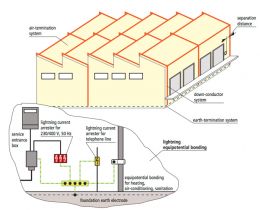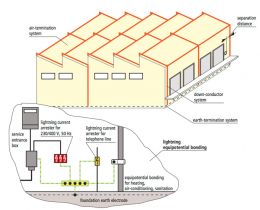Surges - underestimated risk
 The function of a lightning protection system is to protect structures from fire or mechanical destruction and to prevent that persons in buildings are injured or even killed. An overall lightning protection system consists of external lightning protection (lightning protection/earthing) and internal lightning protection (surge protection).
The function of a lightning protection system is to protect structures from fire or mechanical destruction and to prevent that persons in buildings are injured or even killed. An overall lightning protection system consists of external lightning protection (lightning protection/earthing) and internal lightning protection (surge protection).
Functions of an external lightning protection system
Interception of direct lightning strikes via an air-termination system
Safe discharge of lightning current to earth via a down-conductor system
Distribution of the lightning current in the ground via an earth-termination system
Functions of an internal lightning protection system
Prevention of dangerous sparking in the structure by establishing equipotential bonding or keeping a separation distance between the LPS components and other electrically conducting elements
Lightning equipotential bonding
Lightning equipotential bonding reduces the potential differences caused by lightning currents. This is achieved by interconnecting all isolated conducting parts of the installation by means of conductors or surge protective devices.
 Elements of a lightning protection system
Elements of a lightning protection system
According to the EN/IEC 62305 standard, a lightning protection system consists of the following elements:
Air-termination system
Down conductor
Earth-termination system
Separation distances
Lightning equipotential bonding
Classes of LPS
Classes of LPS I, II, III and IV are defined as a set of construction rules based on the corresponding lightning protection level (LPL). Each set comprises level-dependent (e.g. radius of the rolling sphere, mesh size) and level-independent construction rules (e.g. cross-sections, materials).
To ensure permanent availability of complex data and information technology systems even in case of a direct lightning strike, additional measures are required to protect electronic devices and systems against surges.
激增 - 被低估的风险
 防雷系统的功能是保护建筑物免受火灾或机械破坏,并防止建筑物内的人员受伤甚至死亡。整体防雷系统由外部防雷(防雷/接地)和内部防雷(浪涌保护)组成。
防雷系统的功能是保护建筑物免受火灾或机械破坏,并防止建筑物内的人员受伤甚至死亡。整体防雷系统由外部防雷(防雷/接地)和内部防雷(浪涌保护)组成。
外部防雷系统的功能
通过空气终端系统拦截直接雷击
通过引下线系统将雷电流安全释放到大地
通过接地系统在地面上分配雷电流
内部防雷系统的功能
通过在LPS组件和其他导电元件之间建立等电位连接或保持间隔距离,防止结构中出现危险的火花
雷电等电位连接
雷电等电位连接可减少雷电流引起的电位差。这是通过导体或电涌保护器互连装置的所有隔离导电部件来实现的。
根据 EN/IEC 62305 标准,防雷系统由以下元素组成:
空气终端系统
引下线
接地系统
间隔距离
雷电等电位连接
LPS的类别
LPS I、II、III 和 IV 级被定义为基于相应防雷等级 (LPL) 的一组施工规则。每组都包含与水平相关的规则(例如滚动球体的半径、网格大小)和与级别无关的构造规则(例如横截面、材料)。
为了确保复杂的数据和信息技术系统即使在直接雷击的情况下也能永久可用,需要采取额外的措施来保护电子设备和系统免受浪涌的影响。
上一篇:上海:市气象学会首次获批“上海市科技评价机构资质”
下一篇:《雷电防护装置设计核准建议书》中有一条意见是“处于闪电非直接闪击区域的电源线路应选用II级试验的电涌保护器。”怎么理解呢?